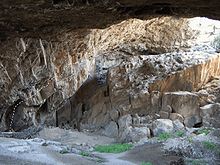Franchthi
The cave of Franchthi ( Greek Φράγχθι ) is located on a bay opposite Kilada in the Argolis on the Peloponnese ( Greece ). It was from the Young Paleolithic (approx. 38,000 BC) to approx. 4000 BC. In use and then partially collapsed.
Research history
The cave was discovered by local archaeologist Adonis Kyrou and excavated in 1967-1979 under the direction of the American classical archaeologist Thomas W. Jacobsen of the University of Indiana as part of the "Argolid Exploration Project" under the direction of Michael Jameson and Jacobsen, who Results published between 1987 and 2018.
stratigraphy
The cave was from approx. 38,000–4,000 BC. Chr. ( Cal ) settled. There is a settlement gap at the transition between the Mesolithic and the Neolithic. Neolithic finds come mainly from the area in front of the cave, Franchthi Paralia.
Paleolithic
The oldest traces of human settlement are spearheads and flint blades from the period from 28,000 to 15,000 BC. Chr.
Neolithic
In the cave, the skeleton of a 1.54 m tall man was discovered who was around 25 years old and was born around the 7th millennium BC. Lived. He belonged to a group of immigrants who, as far as we know, are the oldest group of Neolithic farmers in Greece, but are possibly just one of many. In the youngest layer of the cave, a. Bones of domesticated goats and sheep and remains of domesticated barley and wheat were found.
Environmental history and economy
Soil samples were systematically taken from two of the sections inside the cave, F / A and H / H-1, squares A and B, making the excavation one of the best sources for environmental development in the early Holocene. In addition, grain impressions in Neolithic ceramics were evaluated. Remnants of emmer , barley and lentils (Lens culinaris L.) come from the layers of the early Neolithic ("Initial Neolithic", botanical zone VI according to Hansen, lithic phase X according to Perlès' ).
No archaeobotanical samples were taken from the Neolithic layers of Paralia, but the imprints in the pottery show the presence of einkorn and barley.
storage
Some of the finds are exhibited in the Nafplio Archaeological Museum .
Tourist development
The cave was developed in 2013 with EU funds and is easily accessible. Greek and English plaques explain the history of the cave and its discovery.
literature
- Natalie D. Munro, Mary C. Stiner : Zooarchaeological Evidence for Early Neolithic Colonization at Franchthi Cave (Peloponnese, Greece) , in: Current Anthropology 56.4 (2015), 596-603.
- Στέφανος Γ. Ψημένος: Ανεξερεύνητη Πελοπόννησος , Athens 1998, 227-229. ISBN 960-8481-09-0
Web links
- http://climbargolis.com/produkt2.htm
- Images from the University of Indiana dig
- Julie Hansen, Jane W. Renfrew 1978. Palaeolithic-Neolithic seed remains at Franchti Cave, Greece. Nature 271, 349-352
Individual evidence
- ↑ https://classics.indiana.edu/about/history/in-memoriam/jacobsen-thomas.html
- ↑ Catherine Perlès, Les industries lithiques taillées de Franchthi (Argolide, Grèce) . Bloomington, Indiana University Press: 1987
- ↑ Catherine Perlès, Ornaments and Other Ambiguous Artifacts from Franchthi, Volume 1, The Palaeolithic and the Mesolithic . Indiana University Press. doi: 10.2307 / j.ctt2204qrp , https://www.jstor.org/stable/j.ctt2204qrp
- ↑ Eleni Asouti, Maria Ntinou, Ceren Kabukcu 2018. The impact of environmental change on Palaeolithic and Mesolithic plant use and the transition to agriculture at Franchthi Cave, Greece. PLoS ONE 13/11, e0207805. https://doi.org/ 10.1371 / journal.pone.0207805
- ↑ Traces of Neolithic immigrants in the Argolis
- ^ Julie Hansen, Jane W. Renfrew 1978. Palaeolithic-Neolithic seed remains at Franchti Cave, Greece. Nature 271, 349-352.
- ^ Julie Hansen, Jane W. Renfrew 1978. Palaeolithic-Neolithic seed remains at Franchti Cave, Greece. Nature 271,349
- ↑ Eleni Asouti, Maria Ntinou, Ceren Kabukcu 2018. The impact of environmental change on Palaeolithic and Mesolithic plant use and the transition to agriculture at Franchthi Cave, Greece. PLoS ONE 13/11, e0207805. https://doi.org/ 10.1371 / journal.pone.0207805
- ↑ Susan E. Allen 2018. Second Impressions: Expanding the Range of Cereals from Early Neolithic Franchthi Cave, Greece. Ethnobiology Letters 9/2, 189-196. DOI 10.14237 / ebl.9.2.2018.1065
- ↑ Catherine Perlès 1987, Les industries lithiques taillées de Franchthi (Argolide, Grèce) . Bloomington, Indiana University Press, 94
- ↑ Susan E. Allen 2018. Second Impressions: Expanding the Range of Cereals from Early Neolithic Franchthi Cave, Greece. Ethnobiology Letters 9/2, 189-196. DOI 10.14237 / ebl.9.2.2018.1065
- ↑ Susan E. Allen 2018. Second Impressions: Expanding the Range of Cereals from Early Neolithic Franchthi Cave, Greece. Ethnobiology Letters 9/2, 189-196. DOI 10.14237 / ebl.9.2.2018.1065
Coordinates: 37 ° 25 ′ 20.8 ″ N , 23 ° 7 ′ 56 ″ E

